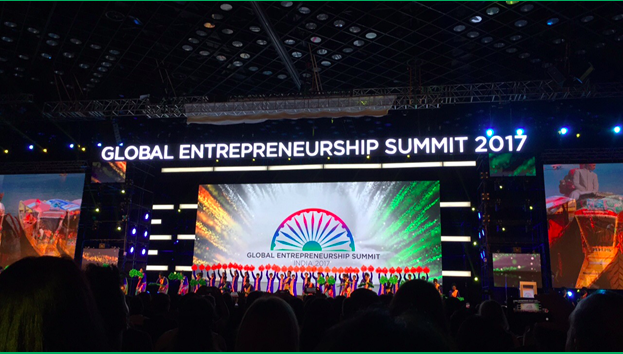The 2017 Global Entrepreneurship Summit and What It Means for Hyderabad

During the final week of November 2017, a group of over 1,500 entrepreneurs and investors flew in to Hyderabad, India for the three-day Global Entrepreneurship Summit. The Summit, founded by Barack Obama, has previously taken place in cities like Nairobi, Tel Aviv and most recently Silicon Valley, and this year marked its first stop in South Asia. The theme of the Summit was “Women First, Prosperity for All,” and was headlined by Prime Minister Narendra Modi and US Presidential Advisor Ivanka Trump. In many ways, for India and for Hyderabad’s home state Telangana, this conference represented a coming of age.
Delegates began landing in Hyderabad’s Rajiv Gandhi airport on Monday, November 27th, with a line of buses waiting to shuttle them to Hyderabad’s newly-built HITEC City. Having opened its first IT block just seven years ago, HITEC City now hosts the massive office complexes of a long list of multinationals from all over the globe, including Google, Tata, Amazon, Facebook, Microsoft, Infosys, and Salesforce (to name a few). Buses took a winding route through acre upon acre of dusty construction sites, with cranes and high-rise hotels casting long shadows over one another. Along the route, rainbow string lights and tropical shrubbery lined roads where beggars may have stood days before.
While some foreign delegates expressed remorse for having to spend the majority of their visit to this beautiful country in a crowded conference center, they were in fact set to see much of what represents modern urban India: a populous group of highly-educated and even-more-highly-aspirational technocrats, infrastructure that moves faster than planning, and a government that has loudly claimed credit for both.
The opening morning of the Summit, as delegates arrived at the Hyderabad International Convention Center and began to trade business cards, Prime Minister Modi made his first stop elsewhere. Having taken a helicopter from the airport, Modi walked up the steps of the Miyapur Metro Station with Chief Minister of Telangana, K Chandrasekhar Rao, and took the first ride to officially inaugurate the system. Throughout India, megacities like Delhi and Bangalore have been plagued with road congestion and pollution, causing burgeoning cities to elevate metro investment to an end-all be-all traffic panacea. And while the Hyderabadi government recently finished a massive outer-ring highway project to ease airport traffic to HITEC City, the urban center has grown increasingly congested. Modi had come to show that the metro, along with other fast-moving development projects (this one finishing only 6 months behind), is a key part of defining the modern Indian city. Like many government initiatives, the opening coincided with the launch of a mobile metro app and a smart card designed with a broader multi-modal transportation plan in mind. Back at the Convention Center, delegates were wandering through a transportation hub of their own. Termed the “Innovation Village,” the hall showcased how drones, Hyperloops, and solar-powered ambulances aim to change how services are delivered in India. To navigate the Innovation Village, delegates were also provided an app, through which they swapped information with one another and highlighted which panels they planned to attend.
Later that afternoon, these participants gathered in the main hall for the opening plenary speeches given by Ivanka Trump and Prime Minister Modi. Ms. Trump spoke about the growing partnership between the US and India, and highlighted several women entrepreneurs, such as Dara Dotz and 15-year old Reyhan Camalova, who founded the startups Field Ready and Rainergy. She specifically called for valuating the work done by women that is currently considered informal, such as housework and family care, harkening back to Miss India Manushi Chhillar’s answer in the Miss World Contest just days before. She spoke about the wide-ranging implications of women’s work being considered “informal,” and highlighted the many challenges across the capital-raising spectrum that women face. Calling on USAID’s microfinance projects and the World Bank’s WeFi initiative to bring millions of dollars to women-run SME’s, Ivanka emphasized the importance of international coordination in approaching social issues. Ms. Trump also mentioned that her father’s administration was “laser-focused” on tax cuts, though didn’t outline the debate over how they would affect burgeoning number of college graduates and small businesses.
Following Ms. Trump’s speech, Modi welcomed the many delegates while wearing his signature vest, a version of which later landed in the gift bag of all delegates, male and female. Prime Minister Modi spoke of ancient innovations like Ayurveda and Yoga, and noted how Telangana’s incubator, T-Hub, was continuing this spirit of innovation on its way to becoming the largest startup hub in South Asia. Modi detailed the efforts of Telangana and greater India to support entrepreneurs, calling out initiatives such as “Make in India” and “Digital India.” Specifically, Modi highlighted the importance of the government’s J.A.M. (Jan Dhan [Bank Account], Aadhar, Mobile) initiative to eradicate black money and increase the flow of resources to those currently left out of the system, especially women. Modi, along with many speakers to follow over the next few days, did note that much had to be done to improve these programs, but focused mainly on their capacity for change. Modi’s speech was capped by a short conclusion by Sushma Swaraj, India’s Minister of External Affairs. As she reflected on the current entrepreneurial environment, she praised Hyderabad as a monument to its progress, as it represented “an elegant mix of modern and traditional.”
The heart of the conference was the central networking lounge, with a floor plan that perfectly intertwined all that the GES aimed to bring together. On the right wall, a series of exhibitions sponsored by the Serendipity Arts Festival showcased the many unique traditional crafts of various regions in India. Paper structures and gold-trimmed textiles sat beside Rajasthani clay sculptures and auto-rickshaw replicas made of woven wood. On the opposite side of the room, GES partners such as Dell, Cognizant, and Intel showed off crafts of their own. In the back, entrepreneurs stood engrossed by try-on demos of Facebook’s Oculus AR. Still more huddled to the front, trading screens and headsets to watch female and male entrepreneurs competing live in a conference-wide case competition. Amongst all this, in the center of the room, delegates connected over coffee and chai in the four areas representing the different industries at GES: “Healthcare and Life Sciences,” “Digital Economy and Financial Technology,” “Energy and Infrastructure,” and “Media and Entertainment.”

As frenzied networking ensued, it was hard to tell who was saying and who was doing. Pre-seed entrepreneurs gave long-winded reports of their future business plans, while more mature startups had learned to clean up their intro. I met with a few entrepreneurs who blended story into impact. A group of entrepreneurs from Bhutan had created a startup ecosystem to facilitate a more circular consumption model. One manages a product delivery service which also collects trash, then sources it to another entrepreneur who recycles the plastics into road materials. Several companies, such as Drinkwell, Spouts of Water, and Water-Gen are using both traditional and modern techniques to improve access to clean, filtered water. The four finalists of the pitch competition – Frontier Markets, Gyan Dhan, Apis Protect, and 7 Generation Games – approach problems such as food security, education, and energy access by integrating technology in thoughtful and human-centered ways.
Successful businesswomen, such as ICICI CEO Chanda Kochhar and British barrister Cherie Blair, discussed the many challenges that women face across the stages of their corporate careers. Whether it was raising the first round of capital funding, staying active in the workplace after childbirth, or breaking into the C-suite, these women called for having the confidence to not allow career aspirations to take the back seat to one’s spouse. This was true of many entrepreneurs in attendance. AnneMarie Horowitz, the founder of the feminist blog Zora & Amelia, started her company during her pregnancy. Raji Borthakur worked with Intel as she created TJay, a smart glove used to better treat her son’s epilepsy. And while more than half of the GES delegates were female, a few companies had business models specifically tailored to empowering women. One of which was Saral Designs, which aims to remove the stigma around menstrual hygiene in India and greatly increase access to these products.

Smart glove created by female entrepreneur, Raji Borthanukar, to treat her son's epilepsy better
In addition to the case competition and evening cultural events, the Summit included panels with industry experts discussing innovation in each sector. Entrepreneurs huddled into “Master Classes” such as “Agri-tech Matters: Feed Billions By Harvesting Technology,” “Payment Platforms, What’s The Next Game-Changer,” and “Knowing the Future: How Artificial Intelligence Will Shape Tomorrow.” Lofty ideas abounded, as a rotating shelf of sectors was reimagined with technological advances like Blockchain and AI to see how each might look. At times, the panels felt more philosophical than practical. Just like our venue on the fast-moving outskirts of Hyderabad, it felt like our discussions in these well-lit, well-ventilated conference rooms were just toeing the edges of the complicated issues of sustainable social change. So much of Indian political doctrine now leans dangerously toward this – technological advancement as a salve for all human issues. Blockchain markets and hyperloops bridging urban areas, without mention of the miles of poor infrastructure between farmers and cities. Demonetization schemes leaving unbanked individuals standing in long lines, slowly seeing their cash become worthless. Building mobile apps for individuals who have never used a phone. In discussions that arose, the mix of “modern and traditional” didn’t seem to be a mix at all.
But time and again, delegates pushed further. While the Digital India scheme increases access to mobile phones and bank accounts for Indian women, what is the benefit if they go unused due to the widespread lack of financial and technological education? What’s the use of investing in incubators across the country if only a small number of those founders are female? Entrepreneurs voiced frustrations with the system, and decided that they would take responsibility for change. Delegates discussed the logistics of scaling water purification technology from continent to continent. Investors with years of experience worked with first-time women entrepreneurs on nailing their pitch. Founders brainstormed how a makerspace in rural Africa could work in urban Central America.
Where there are gaps left by policy, entrepreneurs stand ready to connect theory to practice. As founders, presidents, and CEOs, these individuals have staked their livelihood on progressing toward solutions for social issues. These solutions often do involve technology, but these innovations must be paired with pragmatic, human-centered implementation. At conferences like GES, founders realize that much of this work cannot be done alone, that siloed business models can’t stand the test of time. High off this entrepreneurial energy, delegates left the conference with gift bags in tow. Along with a Modi vest and some other Indian products, there sat a pamphlet marked the “Industrial Policy Framework for the State of Telangana.” A message for women and men to innovate in India, to come back and change the status quo. And maybe, a message from a government that realizes it, too, can’t do everything itself.
Drew DiPrinzio is a former GU India Initiative fellow and is currently residing in Hyderabad, India. He is a Fulbright-Nehru Student Researcher studying the implementation of mobile phone technology in rural areas throughout India. He attended the Global Entrepreneurship Summit as a US delegate. All views are his own, unless otherwise noted. A full version of this article is also posted on his blog, at https://medium.com/@drewdiprinzio. Video footage of the events and panels can be found at https://www.ges2017.org/live/.